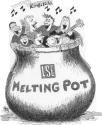|
DIVERSITY OF LOS ANGELES
When the city of Los Angeles was young, it was mostly white anglo-saxons, but during the 1920's, 1930's, and 1940's, Los Angeles became deeply divided racially. As the metropolis and economy expanded, Mexican and the African American population grew in great numbers, but they were concentrated in the hardest and lowest-paying sectors. Also a community of Korean's asked for political asylum and settled in Los Angeles during the year of the Japaneese occupation of Korea, (1905-1945). Chinese immigrants also came to America and were very much discriminated against. Los Angeles became a diverse and multicultural area. The economy of Los Angeles is driven by agriculture, petrolium, motion pictures, aerospace, international trade and tourism. Los Angeles is the largest entry point for immigrants to the U.S. with people coming from every nation. |
|

THE "MELTING POT"
Thanks mainly to war production during WW2 from 1939-1945, it launched a period of astounding growth in Los Angeles that did not slow down until the 1970's. Federal transportation and housing funds poured into the metropolis during the 1940's and 1950's, fueling a massive boom in freeway construction and urban development. The African American community grew from just 75,000 in 1940 to almost 250,000 in 1950. During this period, black people were not permitted to live in more than a handful of neighborhoods, most notably South Central Los Angeles and Watts.
|
SOME "CUTIES" IN THEIR ZOOT SUITS
In 1943, wartime stress in Los Angeles led to the notorious "Zoot Suit Riots", a week-long clash between white, off-duty U.S. sailors and Mexican American youths, identified by the distinctive suits they wore. Over the course of the riots, the sailors beat and harassed Mexican Americans while local authorites looked the other way. Pictured at right is the classic "Zoot Suit". |
|
|
|
ATTRACTIVE IMAGE OF LOS ANGELES
Population growth in Los Angeles jumped from 3 million to 4.7 million between 1940 and 1950. This increase can be attributed to the Cold War demand for the regions defense industries but also to U.S. popular culture. Attractive images of Los Angeles beaches, palm trees, convertible cars and backyard swimming pools flooded U.S. movies, T.V. programs and advertising. |
POPULATION DISTRIBUTION IN 1990
There was no population distribution that I could find during the 1950's or prior. But pictured to the right is the distribution of Los Angeles from the census of 1990. |
|
|
|
|
|
|
|
|
|
|
|
|
|
|
|
|
|
|
|
|
|
|
|
|
|
|
|

